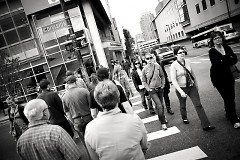Terry Johnston stands at the front of a classroom, safely behind his MacBook Pro. Many would decline the opportunity to be interviewed by a room full of college level writers, as college students can be rather daunting. Vintage pink-rimmed glasses, his trademark and brand, an old stained “Green” activists t-shirt, sleeve tattoo’s, khaki short, and high top Converse shoes are a part of Johnston’s attire. “I hate to dress up,” he remarks, “those days have come and gone.”
It was in Johnston’s senior year at Kendal College of Art and Design that he received an offer of a lifetime. Though it would require him to drop out of college, he decided to accept a job at the now popular computer corporation, Macintosh. After working for Macintosh, Johnston bounced around between several big name corporations, where suits and ties were required. He developed the ample techniques and skills that are needed to be a successful freelance photographer and decided to venture out on his own. In celebration of his freelance venture, Johnston held a celebratory bonfire, burning his collection of proper attire. He now has several galleries across the world and his clientele include Starbucks, The Amway Collection, Getty Images, Varnum and The City of Grand Rapids. It is safe to say that Terry Johnston has “made it” in the world of photography and can now wear whatever he pleases.
One of Johnston’s favorite pastimes involves capturing an individual's true expressions. While his professional work does require some staged shots, Johnston would rather photograph a barista spilling milk, conversing with the customers or simply just making coffee. He explains that, “Even in staged shots, you have to get it right the first time or move on to something else, because the model will lose that sense of authenticity.”
When he is not doing fashion photo shoots or promotional ads, Johnston can be found meandering the streets of popular cities, in coffee shops and in a plethora of obscure locations with one goal: to experiment. He may be developing film in coffee or lemonade or even microwaving a disposable camera to melt the film and crack the lens. One may ask why: because he would rather alter the tool than the product. Johnston believes that once a photograph is taken it should be left alone. It's that raw aspect of photography that pulls Johnston to the streets. They are filled with raw moments just waiting to be captured. Individuals running late for work alongside families joyfully making their way to a local park: where else can a photographer receive such a contrast? Not only are streets filled with people, but things. There is a joy that Johnston receives when elevating seemingly meaningless objects. “If I can make someone stand in awe of something that they would pass by on a daily basis, I think that means something.” It may be a trash can, a wad of paper on the side of the street, a street sign or any number of random objects- he will use them all.
Johnston knows that “it takes time to develop a photographer’s eye,” but he says there are requisites that the average Joe can use to help them better judge and appreciate photography.
When looking at a photo, recognize that the photographer is trying to show something. It may be an emotion, political statement, social statement, or just a captured moment. The subject of a photo is a foundation for a photographer’s intent. It can be a flower, animal, or human, but consider how dissimilar subjects hold a variety of meanings. A child swinging from monkey bars may invoke a series of emotions that are conflicting to the image of a war-torn soldier coming back from the battlefield.
Think of it this way: the subject of a photo is a photographer’s canvas. Camera functions and environmental factors in combination with lens choice and placement are a photographer’s paint and paintbrushes. A photographer uses these techniques and tools to paint a picture for the viewer.
It is also important to consider the compositional quality of a photo. If the levels of light, saturation and white balance are high or low the photographer may be trying to draw your attention, or it may be a mistake. A successful photo gives the viewer an opportunity to see what the photographer sees. If a photographer does not have a strong foundation in their technique, it will reveal itself as a contrast to the subject of the photo. For example, dark and gloomy are not qualities that most individuals have in their wedding photos. However, if those qualities are present, ask, “Why did the photographer choose to do this?”
So how does one judge the intent of a photographer? The same way one judges the technique. Instead of looking for areas of blur, lens flare, saturation, over exposure and how they affect the subject, look for how the subject aligns with the technique. A photographer may have a strong foundation, but if they cannot utilize their technique to promote their subject, it can ruin a photo. “There is a lot more to photography than most people realize.” Johnston believes that “designers make the best photographers." They know how to see an area and are able to recognize how they view it in contrast to how others view it.
It is Johnston's passion for the intent and the execution of photography that really makes him stand out from other artists. Many individuals never really think about the artist behind the camera when looking through a menu, pamphlet, or magazine and if they did, many would not have pictured Terry Johnston with his Apple tattoo and vintage pink rimmed glasses. He’s a man who knows his influences and abilities.
“There is more than enough room in the sea for more photographers. Every single one of them has their place and they are not stepping on my toes.” It’s an interesting balancing act that Johnston has to accomplish in his work. On one end of the spectrum he has produced high grade, technical tandem shots for big name corporations, but on the other end, he feels at home investigating and experimenting on the streets of different cities.
Johnston’s glasses perfectly display his style of photography. It’s how he see’s the world, professional and vintage, with a rather profoundly eye-catching hot pink.
The Rapidian, a program of the 501(c)3 nonprofit Community Media Center, relies on the community’s support to help cover the cost of training reporters and publishing content.
We need your help.
If each of our readers and content creators who values this community platform help support its creation and maintenance, The Rapidian can continue to educate and facilitate a conversation around issues for years to come.
Please support The Rapidian and make a contribution today.




Comments
Mark thank you for taking the time to write this! I often get worried when being interviewed but you totally got me - perfect representation of me, myself and I, you are amazing!
Thanks for the article Mark. Nice read!
Liked reading this profile of my photography mentor.
Why thank you everyone! It was a fun write. :)
Thanks for publishing it on The Rapidian!
Nice article. I'm inspired to go out and shoot now!